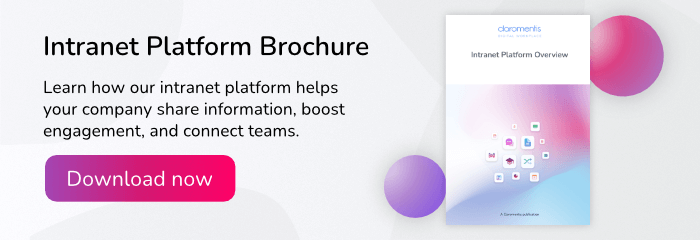Your employees want to have a voice. It’s one of their most powerful tools – a way to share their unique perspectives and contribute to your company’s success.
Yet a quarter of UK workers claim they don’t have a voice in the workplace at all.
These voiceless employees experience feelings of powerlessness and underappreciation. They’re also more likely to suffer from greater levels of disengagement and company dissatisfaction – all of which can lead to diminishing productivity and a high turnover rate.
If you want to turn this around, you need to give your employees the opportunity to speak up and share their honest opinions – without fear of punishment. Only then can you work towards fixing problem areas and increasing your retention and engagement rates.
This is where effective employee engagement surveys can become an invaluable tool for your internal comms team.
What is an employee engagement survey?
Employee engagement surveys are questionnaires that capture employee feedback and sentiments regarding your company. Through the quantitative and qualitative insights gathered, you can better understand:
Though there’s no hard rule for how often you release these surveys, a minimum of once a year is considered best practice. You can also push out shorter ‘employee pulse’ surveys on a monthly basis, should that suit your business needs.
What are the benefits of conducting an employee engagement survey?
Effective surveys can benefit your business in a number of ways:

7 ways to improve your employee engagement survey response rates
Employee surveys are only as useful as the quantity and quality of the feedback given. In order to increase the effectiveness, you need to strive for a high response rate and ensure that all responses are as truthful as possible.
Here’s how:
1. Announce the survey in advance
Your employee engagement survey is vital for improving your culture, employee experiences and engagement levels. So give it the attention it deserves and communicate its release with a bang rather than a whimper.
Use an effective communication method – such as a company-wide meeting – to share:
Be sure to amp up the reminders after this – and throughout the duration of your survey run-time. We’d recommend creating announcements on your intranet, sending email or Slack reminders, and encouraging team leaders to mention the survey in their team catch ups.
2. Use an intuitive survey tool
If you email a third-party survey to your employees, the chances are it may get lost in their inbox. Even if they do find it, they may forget to fill it out during their busy working week.
To increase the likelihood of employees responding, harness your centralised internal communications platform.
A comprehensive solution should come ready-made with a polls and survey application. This will allow you to create short or long-form surveys, promote them on your familiar company intranet, and encourage better adoption.
3. Optimise your survey design
As the band KISS say: Keep It Simple, Stupid.
Overly long surveys require time that your employees may not have. Even if they do muscle through, they may encounter survey fatigue along the way. This is a phenomenon where respondents grow tired and their responses deteriorate as the survey progresses.
Ideally, your engagement and pulse surveys should be concise, focused and relevant, and take no longer than 15 minutes to complete.
On top of this, make sure your survey is as accessible as possible:
4. Create targeted surveys
Are there one or two departments that are underperforming more than the others? If your engagement problems reside in one area of the business, it may be useful to implement a more focused survey.
With a departmental or job-role focused approach, you can ask questions geared towards specific team OKRs, responsibilities and challenges. This is more likely to engage your employees and, as an added benefit, give you highly-specific data to work with.
5. Consider anonymisation
While this is entirely optional, it’s worth noting that employees are more likely to provide feedback if you anonymise their answers.
This anonymisation can also improve the truthfulness of their responses. When employees feel like they can share insights about your company and their role within it without retaliation, they’re more likely to be honest.
Anonymisation can also encourage employees to share personal information about more sensitive topics, such as their mental well being.
6. Incentivise participation
This isn’t strictly necessary. However, if you find that response rates are below average in your organisation, incentives may be the best way to motivate your employees. This may be as simple as offering an early finish on a Friday afternoon or, in some cases, a gift voucher.
You may also want to incentivise your employees by demonstrating how their feedback can benefit them in the long run. This leads us on to our next point:
7. Show that employee feedback can make a difference
Employees frequently mistrust surveys and the intentions behind them, with many believing their employers don’t actually want candid feedback.
This mistrust can lead to fewer responses and/or low quality feedback – both of which can seriously impede or misguide your employee engagement efforts.
To tackle this issue, make honesty a core part of your company culture. Embed transparency in your values and create policies that encourage feedback without repercussion. This will help your employees feel more able to share critical feedback.
But your efforts shouldn’t stop there.
After your survey is complete and you’ve had a chance to analyse the findings, share the results with your employees and walk them through the next steps. For example, if your survey highlighted that employees feel underappreciated, communicate how you’ll fix the problem. How will you encourage leader-to-employee recognition? What additional benefits can you offer your employees?
If people think their participation leads to positive action, they’re more likely to take your next survey and encourage their peers to do the same.
30 examples of great employee engagement survey questions
Now let’s take a look at some examples of good employee engagement questions. Remember, these questions should be relevant, succinct and easily understood – that way, you’ll increase response rates and reduce the likelihood of survey fatigue.
In addition to this, consider using a mixture of quantitative and qualitative question types, such as scales, multiple choice and text-based. Quantitative questions will give you number-based responses that’ll come in useful for report generation; qualitative questions will capture nuanced employee feedback. Both are important for measuring engagement and understanding where you can make improvements.
With this in mind, here are some questions you can use in your next engagement survey:
- How satisfied or dissatisfied are you with your ability to do interesting work in your role?
- How satisfied or dissatisfied are you with your ability to apply your skills in this role?
- How satisfied or dissatisfied are you with your current workload?
- How satisfied or dissatisfied are you with your opportunities for career progression?
- How satisfied or dissatisfied are you with the physical environment at your workplace?
- How satisfied or dissatisfied are you with your relationship with your manager?
- Overall, how satisfied or dissatisfied are you with your current employer?
- How valued do you feel at work by your colleagues and superiors?
- On a scale of 1 to 10, how would you rate your work-life balance?
- How often do you feel stressed at work, and what are the main contributors to your stress?
- Do you feel you have the tools and resources needed to perform your job effectively?
- How transparent do you think management is in communicating important decisions and changes?
- On a scale of 1-10, how comfortable do you feel providing feedback to your superiors?
- How often do you receive recognition or praise for doing good work?
- Do you feel your opinions are considered in decision-making processes within your team or department?
- How well do you understand the strategy, purpose and vision of the company?
- How well do you understand the path for career advancement within the organisation?
- How would you describe the culture of our organisation?
- On a scale of 1-10, how well does your organisation support your professional development and learning?
- How satisfied are you with the teamwork and collaboration within your department?
- How well do you think you embody our organisation’s values?
- To what extent do you believe your work contributes to the company’s goals and objectives?
- How confident are you in the leadership of this organisation?
- How effectively do you think our company handles diversity and inclusion?
- Do you feel safe and supported in the workplace?
- How likely are you to recommend our company as a great place to work to friends and family?
- What aspects of our company would you recommend to your friends and family?
- How well do our company values align with your personal values?
- How satisfied are you with the benefits package provided by the company?
- What changes would you like to see in the workplace to improve employee satisfaction and engagement?
One piece of your wider internal comms strategy
A well-constructed survey can significantly benefit your employee engagement, retention and candidate attraction rates.
But, remember: it’s only one puzzle piece of your internal communications strategy.
With a high number of employees suffering from disengagement and survey mistrust, you need to champion a more comprehensive internal comms strategy. One that encourages honesty, open communication and transparency year-round – not just in your annual questionnaires.
To build a more successful and sustainable internal comms strategy, download our latest Internal Communications Strategy guide. It’s packed full of insights and actionable recommendations for this year and beyond.





